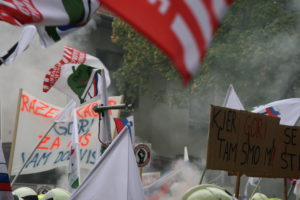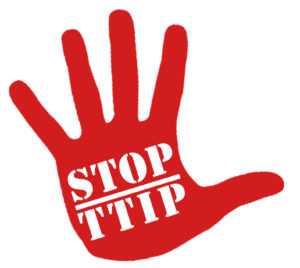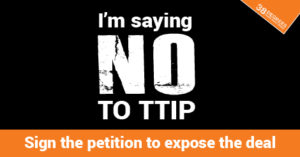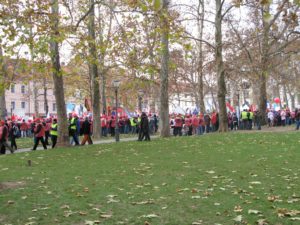Sounding of public space is one of the important ways of active participation in global citizenship and politics of belonging. The socio-political changes in European cities, particularly after the world financial crisis in 2008 (in Ljubljana after 2012), have fostered a more activist-oriented population, which has led to diverse expressions of resistance and civil disobedience. When the protesters raised their voices against the cultural and symbolic restructuring of the city, they also used sound. Here are some of the protest sounds in public places – squares, streets and parks – which reflect the co-creation of sound and space, and the potential of such co-creating for the formation of sensory politics as a means of new forms of political participation.
First and foremost, we focus on the larger protests in Ljubljana between January 2014 and October 2017. Most of the protests were part of global movements (for example, a protests against TTIP, Refugees Welcome, March of Science and International Women’s Day), but some had national cause (anti-government protests, firefighters’ protest).
Although these protests do not always carry the same political message, all address economic instability, uncertainty and structural problems that people face at the local, regional, national and global level. Protests were held in central urban spaces that have gone through sound reconfiguration. For example, in recent years, Congress Square has become an extremely important urban public space, used for experimenting with new models of political participation.
- Anti-TTIP (Transatlantic Trade and Investment Partnership) protest in eight European cities (Hamburg, Berlin, Madrid, Helsinki, London, Vienna, Paris), including in Ljubljana, Prešeren Square, 14.10.2014. Recorded by: Polona Sitar.
-
Anti-government protest, Congress Square, 29. 10. 2014. Recorded by: Ana Hofman.
- Anti-government protest – a gathering, Congress Square, 29. 10. 2014. Recorded by: Ana Hofman.
- “If our lives are not worth anything, we protest”, the protest on the International Women’s Day, the appearance of the feminist choir “Z’borke”, Congress Square, 8. 3. 2016. Recorded by: Ana Hofman.
- “Refugees welcome” – a protest with the support of refugees, Kotnikova Street, 27. 2. 2016. Published: Youtube.
- “Youth Relay” – a concert for unlimited use of ROG, Trubarjeva Street, 25. 5. 2016. Recorded by: Ana Hofman.
- Protest Against Refugees, Republic Square, 27. 8. 2016 Published: Youtube.
- Protest for science, Modern gallery, 19. 4. 2017. Recorded by: Miha Peče.
- Protest of firefighters, Congress Square, 5. 10. 2017. Recorded by: Mojca Kovačič.
Sound objects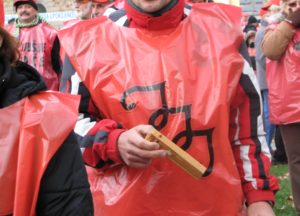
Most recognizable sounds of protests were whistles, rumbling, trumpets, bells, kitchenware used to carry out rhythmic patterns. Such sound objects have proven to be more frequently used for protest walks or marches.
Singing bodies
Another important sound markers of protests’ sounds was collective, mass singing, usually accompanied by cheers and clapping. Protesters have selected some well-known songs, which enabled intensive experience of shared sense of sociality and unity in collective singing.
Soundscape of activist musicians
On several protests, activist-musicians and bands were the main musical support who have played an important role in shaping the protest soundscape. Their performances have also confirmed the important role of artists in voicing resistance to redistribution of power in urban public spaces.
Music from the loudspeakers
Protesters often used recorded music and played it through mid-tone loudspeakers, powered by a generator. Music from the speakers, from instrumental to vocal well-known songs (for example, Ciao Bella, Slovenian national anthem), was usually intertwined with the other protest sounds of whistles, shouting, ambient noises and sounds of generators.

